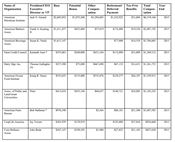|
A Closer Look At CEO Salaries
SARA WYANT
WASHINGTON, D.C.
For the last two decades or so, I’ve spent a good chunk of my summer reading tax forms filed by some of the leading farm organizations and commodity groups. Why? It’s a pain-staking exercise but helps board members and others better understand how to best compensate their chief executive officers who are often asked to go toes-to-toes with other CEOs on their behalf and manage multi-million dollar organizations.
The process started innocently enough when a farmer told me how much he heard the CEO of a commodity organization was making back in the early 1990’s. The number seemed hard to believe, but honestly, I didn’t know what an appropriate level was for this individual. He was a board member and didn’t know either.
After all, most organizations pay according to a variety of factors – usually dependent on the size of the organization’s revenues. So I set on a mission to figure out not only how much that individual made, but others in similar positions.
I discovered that all non-profits have to disclose that amount on the tax forms they file with the Internal Revenue Service. My first report focused on the CEOs of just a handful of commodity organizations and created quite a ruckus. One of the CEOs told me that he would love to know how much others in a similar position made but that – if I ever reported his salary – he would never speak to me again.
I did and he didn’t.
This year, our intern Ali Luety and I looked at the CEO salaries for 109 organizations who touch or compete against farm organizations. Like recent years, the CEO salaries at major nonprofit trade organizations in the agriculture, food and energy space have continued their climb upward.
CEO salary levels and benefit packages often reflect the size of the organization, responsibilities, and geographic location. But increasingly, “other” compensation for these busy executives includes travel for spouses on business trips, reimbursement for cellphone bills, club membership and much more.
For example, the American Bankers Association’s CEO Tom Keating II is provided with first class airfare for himself and companions, financial planning with tax preparation, social club dues for business use, and a driver – mostly for business, but personal is covered, too, according to the association's 990 tax form, which the Internal Revenue Service requires all nonprofits to file and make publicly available. Keating’s total compensation topped $2 million in 2015.
According to a recent report from ASAE on 2016-2017 benefits, 34 percent of the associations that offer CEO-specific benefits provide for spouse or companion travel and almost 80 percent cover mobile phone monthly fees. Over half cover device purchases, too. More organizations are also covering tablet purchases – 38.5 percent – and 22.6 percent cover the monthly fees for tablets.
Agri-Pulse relies primarily on non-profit tracker Guidestar.org for obtaining compensation information but also contacted dozens of organizations – some which had not yet reported their 2016 data but offered their most recent year on file. USDA’s Agricultural Marketing Service provides data on checkoff board CEOs for this report.
The American Petroleum Institute’s Jack Gerard, who was brought on board as CEO in November 2008, once again comes out the heavyweight champion for this year’s report, with a base salary of $2.68 million. His base salary saw no major increase from the prior year, but his bonus jumped by about $215,000 and he got a $400,000 boost in his retirement/deferred payment, bringing his total compensation for 2015 to $6.3 million. This year he earned nearly double what the next highest CEO on our list earned and millions more than those who represent one of his frequent targets – the ethanol industry.
Dawn Sweeney, head of the National Restaurant Association, came in at second highest earner on our list of food, farm, energy and rural leaders. She started out with a base salary of $1.296 million and with benefits, her total compensation package reached nearly $3.49 million.
Earning the third highest compensation package on our list is Pamela Bailey, who heads up the Grocery Manufacturers Association. Bailey, who’s been with GMA for almost nine years, earned $1.2 million as a base salary. With a retirement/deferred payment of over $1.1 million, Bailey earned a total compensation of $3,032,292.
Here’s the top ten from this year’s Agri-Pulse report on CEO compensation. For the entire list, go to: www.Agri-Pulse.com . ∆
Editor’s note: Ali Luety contributed to this report.
SARA WYANT: Editor of Agri-Pulse, a weekly e-newsletter covering farm and rural policy. To contact her, go to: http://www.agri-pulse.com/

|
|